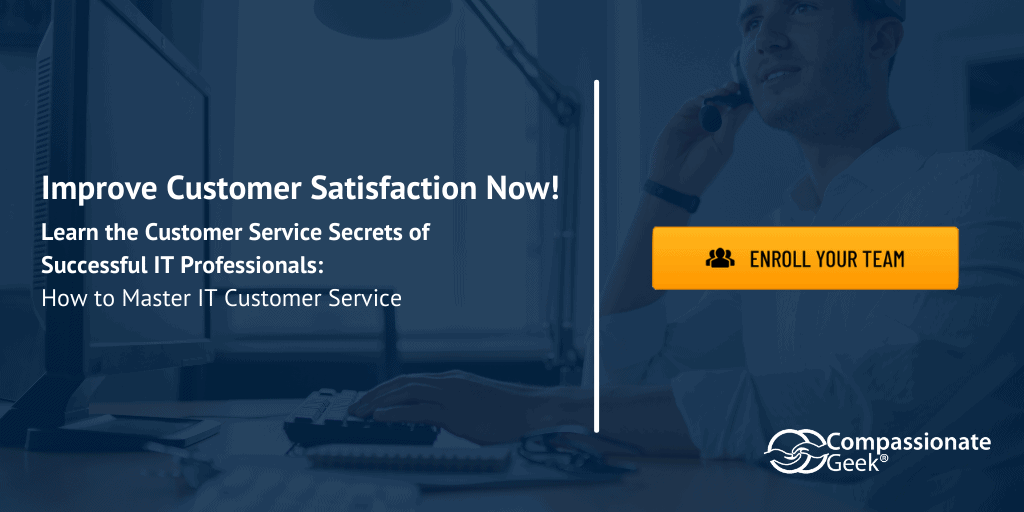Customer service in IT is part of the overall customer experience. Think of customer service as when your company or department interacts with the people you serve. Customer experience includes customer service, website usability, product or service functionality, environment, and everything else that affects how the end-user or customer feels about their relationship with your department, agency, or business.
For the purpose of this post, a customer is anyone who needs your unique talents, abilities, and knowledge. It might be an end-user, paying customer, one of your peers, your boss, or anyone else you serve, either directly or through the products and services you manage.
Customer Service in IT
In IT, customer service is when you, artificial intelligence (such as a chatbot), or some other system interact with an end-user or other customer to answer questions, solve problems, or notify of changes. You might also manage orders and cancellations. It is not limited to front-line tech support agents. For example, if you’re a network engineer, your customers are the people who use the network. You provide customer service when they notify you of problems, such as accessing a network resource. If you’re a database administrator, your customers might include web developers working on dynamic websites with database integration.
Customer Experience in IT
Customer experience in IT encompasses IT customer service. It also includes things like network speed, reliability, and security. The usability of internal dashboards, apps, and interfaces is also part of the IT customer experience. How intuitive are customer dashboards? How easily can they requisition new hardware? How well are software upgrades supported?
Customers, whether internal end-users, external paying customers, or even your coworkers need an excellent customer experience in order to perform at an optimal level. Often, IT customer experience involves making compromises between security, usability, and end-user demands. For example, you may want to implement two-factor authentication throughout your network, knowing that it adds another layer of security. Your executive team, however, pushes back against the policy due to the added complexity for end-users in setting it up and using it. Your compromise might be that you implement 2FA for more privileged users or for more sensitive resources while maintaining traditional username and password authentication in other areas. In such a configuration, customer experience involves the ease-of-use issues, while customer service involves the support for the users trying to navigate 2FA in your network.
When you think about customer experience, consider the user’s overall experience. How easily can they access network resources? How fast is the network? Is the hardware and software current or is it old and buggy? (Yes, I realize new software can be buggy, too!) Are workstations well-maintained? Appearances matter, so take a look at cable management, especially in end-user areas.
Customer Experience Can Create Advocates or Detractors
As you think about your individual work and the work of your department, ask yourself if you’re creating advocates or detractors among the people you serve. Advocates will speak well of you behind your back. They’ll speak in your defense when you’re not there to defend yourself. Detractors do the opposite. They share their frustration with you or your department with anyone who will listen. Your customer’s experience will largely determine whether they’re advocates or detractors.
One of the great paradoxes of IT is that people notice us the least when we’re at our best. When our systems are working transparently, our users barely notice us. That makes for a great customer experience.
Next Level IT Customer Service Training
Enroll your team now in Compassionate Geek IT online customer service training so they can work together, get things done, and take care of customers.

